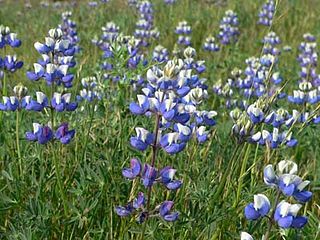
Lupinus polyphyllus, the large-leaved lupine, big-leaved lupine, many-leaved lupine, blue-pod lupine, or, primarily in cultivation, garden lupin, is a species of lupine (lupin) native to western North America from southern Alaska and British Columbia east to Quebec, and western Wyoming, and south to Utah and California. It commonly grows along streams and creeks, preferring moist habitats.

Lupinus, commonly known as lupin, lupine, or regionally bluebonnet etc., is a genus of flowering plants in the legume family Fabaceae. The genus includes over 199 species, with centers of diversity in North and South America. Smaller centers occur in North Africa and the Mediterranean. They are widely cultivated, both as a food source and as ornamental plants, although in the Nordic countries and New Zealand's South Island, introduced lupins are viewed as a severe environmental threat.

Lupinus arboreus, the yellow bush lupine (US) or tree lupin (UK), is a species of flowering plant in the legume family Fabaceae.

Podocarpus nubigenus is a species of podocarp, endemic to the Valdivian temperate rain forests of southern Chile and adjacent southwestern Argentina. It is the southernmost podocarp in the world. It grows from 38°S to Ultima Esperanza (53°S), in wet and swampy soils. It can settle clear grounds, with a faster growth than the other Chilean Podocarpaceae.

Lupin or lupini beans are the yellow legume seeds of the genus Lupinus. They are traditionally eaten as a pickled snack food, primarily in the Mediterranean basin, Latin America and North Africa. The most ancient evidence of lupin is from ancient Egypt, dating back to the 22nd century BCE. The bitter variety of the beans are high in alkaloids and are extremely bitter unless rinsed methodically. Low alkaloid cultivars called sweet lupins have been bred, and are increasingly planted. Lupin beans are growing in use as a plant-based protein source around the world.

Lupinus nanus, the sky lupine, field lupine, dwarf lupin, ocean-blue lupine or Douglas' annual lupine, is a species of lupine native to the western United States. It is found natively in California, Nevada, and on Steens Mountain in eastern Oregon. It tends to grow on slopes and in open or disturbed areas below 1300 meters.

Lupinus angustifolius is a species of lupin known by many common names, including narrowleaf lupin, narrow-leaved lupin and blue lupin. It is native to Eurasia and northern Africa and naturalized in parts of Australia and North America. It has been cultivated for over 6000 years as a food crop for its edible legume seeds, as a fodder for livestock and for green manure.

Lupinus perennis is a flowering plant in the family Fabaceae. It is widespread in the eastern part of the USA and Minnesota, Canada, and on the coasts of the Arctic Ocean, where it grows in sandy areas such as dunes and savannas.
Lupinus foliolosus is a species of legume in the family Fabaceae. It is found only in Ecuador. Its natural habitat is subtropical or tropical high-altitude grassland.
Lupinus kuntii is a species of legume in the family Fabaceae. It is found only in Ecuador. Its natural habitat is subtropical or tropical high-altitude grassland.
Lupinus macbrideanus is a species of legume in the family Fabaceae. It is found only in Peru.
Lupinus michelianus is a species of legume in the family Fabaceae. It is found only in Ecuador. Its natural habitat is subtropical or tropical high-altitude grassland.
Lupinus rupestris is a species of legume in the family Fabaceae. It is found only in Ecuador. Its natural habitat is subtropical or tropical high-altitude grassland.
Lupinus smithianus is a species of legume in the family Fabaceae. It is found only in Ecuador. Its natural habitat is subtropical or tropical high-altitude grassland.

Lupinus excubitus is a species of lupine known as the grape soda lupine. Its common name refers to its sweet scent, which is said to be very reminiscent of grape soda. This species and its variants are found in Southwestern United States, especially in California and Nevada, e.g., Death Valley and Joshua Tree National Parks, and northwestern Mexico.

Bluebonnet is a name given to any number of purple-flowered species of the genus Lupinus predominantly found in southwestern United States and is collectively the state flower of Texas. The shape of the petals on the flower resembles the bonnet worn by pioneer women to shield them from the sun. Species often called bluebonnets include:

Leptotes webbianus, the Canary blue, is a butterfly in the family Lycaenidae. It is endemic to the Canary Islands.

Lupinus pubescens is a lupine flower which is native to the high Andes, but can also be found in China, Colombia, Ecuador, and Venezuela.

The genus Lupinus L. and, in particular, its North-American species, were divided by Sereno Watson (1873) into three parts: Lupinus, Platycarpos and Lupinnelus. Differences in habit and in the number of ovules were accepted as the basis for this classification. A majority of perennial and annual species from the American continent described by Watson were referred to Lupinus. To the Platycarpos section were attributed some annual species with two ovules in the ovary and two seeds in the pod. Section Lupinnelus consisted of one species, with axillary and solitary flowers, scarcely reflexed banner, and also with two ovules in the ovary. Presently, the existence of such species seems doubtful.













